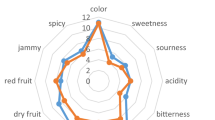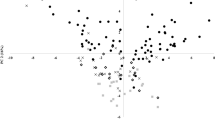Abstract
In this paper, ‘Beibinghong’ dry red wine from six Vitis amurensis producing areas (Kuandian County, Liuhe County, Zuojia Town, Songyuan City, Ji’an City, Dongning City) in Northeast China was discussed and evaluated. Research findings were made based on three aspects: mineral elements, volatile compounds, and sensory characteristics. Results of mineral tests show that Ca and K levels in the Kuandian sample were significantly higher than those in other producing areas; and that the Songyuan sample was the highest in Na, Mg, Cu, and Fe among the samples. Also, samples from Dongning and Ji’an were highlighted through quantitative analyses of 46 volatile compounds, with more species of esters reflecting fruity flavor and higher alcohol levels. Finally, Songyuan and Dongning samples stand out with unique profiles compared to the others in PCA analysis of 11 odor substances with OAV > 1, and ranked as top two in sensory evaluation, while Kuandian, Liuhe, and Zuojia samples are relatively similar. Evidence can be found among the samples that Ethyl octanoate, Ethyl 3-methylbutanoate-M, Ethyl acetate, and Iso-propanol had a significant influence on the smell of ‘Beibinghong’ dry wine.








Similar content being viewed by others
Abbreviations
- KD:
-
Kuandian Manchu Autonomous County, Liaoning Province
- LH:
-
Liuhe County, Jilin Province
- ZJ:
-
Zuojia Town, Jilin Province
- SY:
-
Songyuan City, Jilin Province
- JA:
-
Ji’an City, Jilin Province
- DN:
-
Dongning City, Heilongjiang Province
References
Rungang S, Wenpeng LU, Yujie S, Renhao JIN, Xiaohong LI, Zhengui GUO, Jingkuan LIU, Xinggui LIN (2008) A new ice-red brewing grape cultivar ‘Beibinghong.’ Acta Horticulturae Sinica 35(7):1085
Wang PF, Yang Y, Shi HM, Wang YM, Ren FS (2019) Small RNA and degradome deep sequencing reveal respective roles of cold-related microRNAs across Chinese wild grapevine and cultivated grapevine. BMC Genomics 20(1):7–12. https://doi.org/10.1186/s12864-019-6111-5
Lan YB, Qian X, Yang ZJ, Xiang XF, Yang WX, Liu T, Zhu BQ, Pan QH, Duan CQ (2016) Striking changes in volatile profiles at sub-zero temperatures during over-ripening of ‘Beibinghong’ grapes in Northeastern China. Food Chem 212:172–182. https://doi.org/10.1016/j.foodchem.2016.05.143
Lan YB, Xiang XF, Qian X, Wang JM, Ling MQ, Zhu BQ, Liu T, Sun LB, Shi Y, Reynolds AG, Duan CQ (2019) Characterization and differentiation of key odor-active compounds of ‘“Beibinghong”’ icewine and dry wine by gas chromatography-olfactometry and aroma reconstitution. Food Chem 287:186–196. https://doi.org/10.1016/j.foodchem.2019.02.074
Chowaniak M, Rashidov N, Niemiec M, Gambus F, Lepiarczyk A (2020) The impact of training systems on productivity and GHG emissions from grapevines in the Sughd Region in Northern Tajikistan. Agronomy-Basel 10(6):9. https://doi.org/10.3390/agronomy10060818
Sagrista E, Sarda R (2020) Climate change impact assessment on grape and wine for Ontario, Canada’s appellations of origin. Reg Environ Change 20(3):4. https://doi.org/10.1007/s10113-020-01673-y
de Resseguier L, Mary S, Le Roux R, Petitjean T, Quenol H, van Leeuwen C (2020) Temperature variability at local scale in the bordeaux area. Relations with environmental factors and impact on vine phenology. Front Plant Sci 3:11. https://doi.org/10.3389/fpls.2020.00515
Ju Y-l, Liu M, Tu T-y, Zhao X-f, Yue X-f, Zhang J-x, Fang Y-l, Meng J-f (2018) Effect of regulated deficit irrigation on fatty acids and their derived volatiles in ‘Cabernet Sauvignon’ grapes and wines of Ningxia, China. Food Chem 245:667–675. https://doi.org/10.1016/j.foodchem.2017.10.018
Zhao P, Xia WX, Wang JB, Zhang XG, Zhuang Y, Lu QX, Chen SS (2018) Fungal diversity of rhizosphere soil from 11 varieties o grapevines at maturity stage from two vineyards in China. J Biobased Mater Bioenergy 12(4):356–361. https://doi.org/10.1166/jbmb.2018.1784
Brescia MA, Caldarola V, De Giglio A, Benedetti D, Fanizzi FP, Sacco A (2002) Characterization of the geographical origin of Italian red wines based on traditional and nuclear magnetic resonance spectrometric determinations. Anal Chim Acta 458(1):177–186. https://doi.org/10.1016/s0003-2670(01)01532-x
Jiang B, Xi ZM, Luo MJ, Zhang ZW (2013) Comparison on aroma compounds in cabernet sauvignon and merlot wines from four wine grape-growing regions in China. Food Res Int 51(2):482–489. https://doi.org/10.1016/j.foodres.2013.01.001
Douglas D, Cliff MA, Reynolds AG (2001) Canadian terroir: characterization of Riesling wines from the Niagara Peninsula. Food Res Int 34(7):559–563. https://doi.org/10.1016/s0963-9969(01)00071-0
Zhang L, Tao YS, Wen Y (2013) Aroma evaluation of young chinese merlot wines with denomination of origin. S Afr J Enol Vitic 34(2):307–307
Dou S, Guo D (2018) Soil type distribution and black soil land protection in Jilin Province. J Jilin Agricult Univ 40(4):449–456
Zhao HF, Xie XQ, Read P, Loseke B, Gamet S, Li WK, Xu CM (2018) Biofortification with selenium and lithium improves nutraceutical properties of major winery grapes in the Midwestern United States. Internat J Food Sci Technol. https://doi.org/10.1111/ijfs.14726
Pettinelli S, Pollon M, Costantini L, Bellincontro A, Segade SR, Rolle L, Mencarelli F (2020) Effect of flotation and vegetal fining agents on the aromatic characteristics of Malvasia del Lazio (Vitis vinifera L) wine. J Sci Food Agricult. https://doi.org/10.1002/jsfa.10577
Pisarnitskii AF (2001) Formation of wine aroma: tones and imperfections caused by minor components (review). Appl Biochem Microbiol 37(6):552–560. https://doi.org/10.1023/a:1012390731145
Caldeira I, Anjos O, Portal V, Belchior AP, Canas S (2010) Sensory and chemical modifications of wine-brandy aged with chestnut and oak wood fragments in comparison to wooden barrels. Anal Chim Acta 660(1–2):43–52. https://doi.org/10.1016/j.aca.2009.10.059
Capone S, Tufariello M, Francioso L, Montagna G, Casino F, Leone A, Siciliano P (2013) Aroma analysis by GC/MS and electronic nose dedicated to Negroamaro and Primitivo typical Italian Apulian wines. Sens Actu B-Chem 179:259–269. https://doi.org/10.1016/j.snb.2012.10.142
Baiao LF, Oliveira AS, Goncalves A, de Pinho PG, Valente LMP, Cunha LM (2020) Analysis of volatile compounds in Paracentrotus lividus by HS-SPME/GS-MS and relation to its sensorial properties. Lwt-Food Sci Technol. https://doi.org/10.1016/j.lwt.2020.109629
Tian HX, Xu XL, Sun XF, Chen C, Yu HY (2020) Evaluation of the perceptual interaction among key aroma compounds in milk fan by gas chromatography?olfactometry, odor threshold, and sensory analyses. J Dairy Sci 103(7):5863–5873. https://doi.org/10.3168/jds.2019-17880
Raza A, Song H, Begum N, Raza J, Iftikhar M, Li P, Li K (2020) Direct classification of volatile organic compounds in heat-treated glutathione-enriched yeast extract by headspace-gas chromatography-ion mobility spectrometry (HS-GC-IMS). Food Anal Methods. https://doi.org/10.1007/s12161-020-01847-8
Hannum ME, Forzley S, Popper R, Simons CT (2020) Further validation of the engagement questionnaire (EQ): do immersive technologies actually increase consumer engagement during wine evaluations? Food Qual Prefer. https://doi.org/10.1016/j.foodqual.2020.103966
Xiao Z, Zhou X, Niu Y, Zhao F (2017) The analysis of the characteristic aroma components of cherry wine by gas chromatography-olfactometry(GC-O) and odor activity values(OAV). J Chinese Instit Food Sci Technol 17(8):246–254
Li PC, Wang JJ, Su XD, Guo SJ, Li M, Fu XF (2017) Semilethal temprature and comprehensive evaluation of eight kinds of grape rootstock of hardiness. proceedings of the 2016 International Conference on Biotechnology and Medical Science.
Mao J, Li Y (2019) Comparative analysis of aroma components of black chokeberry wine and Cabernet Sauvignon wine. Food Sci 40(22):270–276
Schelezki OJ, Antalick G, Suklje K, Jeffery DW (2020) Pre-fermentation approaches to producing lower alcohol wines from Cabernet Sauvignon and Shiraz: implications for wine quality based on chemical and sensory analysis. Food Chem. https://doi.org/10.1016/j.foodchem.2019.125698
Zheng F, Han MX, He Y, Zhang Y, Liu SY, Yue H, Wen LK (2019) Biotransformation of anthocyanins from Vitis amurensis Rupr of ‘Beibinghong’ extract by human intestinal microbiota. Xenobiotica 49(9):1025–1032. https://doi.org/10.1080/00498254.2018.1532132
He Y, Wen LK, Liu JS, Li YR, Zheng F, Min WH, Yue H, Pan PQ (2018) Optimisation of pulsed electric fields extraction of anthocyanin from ‘Beibinghong’ Vitis Amurensis Rupr. Nat Prod Res 32(1):23–29. https://doi.org/10.1080/14786419.2017.1324963
Tangolar S, Tangolar S, Turan M, Ates F (2018) Determination of phytochemical and mineral contents of seeds from ‘Semillon’ and ‘Carignane’ Wine grape cultivars grown under different irrigation conditions. Erwerbs-obstbau. https://doi.org/10.1007/s10341-020-00516-8
Karimali D, Kosma I, Badeka A (2020) Varietal classification of red wine samples from four native Greek grape varieties based on volatile compound analysis, color parameters and phenolic composition. Eur Food Res Technol 246(1):41–53. https://doi.org/10.1007/s00217-019-03398-7
Longo R, Blackman JW, Antalick G, Torley PJ, Rogiers SY, Schmidtke LM (2018) Volatile and sensory profiling of Shiraz wine in response to alcohol management: comparison of harvest timing versus technological approaches. Food Res Int 109:561–571. https://doi.org/10.1016/j.foodres.2018.04.057
Revi M, Badeka A, Kontakos S, Kontominas MG (2014) Effect of packaging material on enological parameters and volatile compounds of dry white wine. Food Chem 152:331–339. https://doi.org/10.1016/j.foodchem.2013.11.136
Espitia-Lopez J, Luna H, Escalona-Buendia HB, Verde-Calvo JR (2018) Identification, quantification, and sensory profile of esters and alcohols of a Mexican red Merlot wine comparing barrel ageing with wood chips, using a multivariable analysis. J Food Proc Preserv 42(2):6. https://doi.org/10.1111/jfpp.13433
Peng C-T, Wen Y, Tao Y-S, Lan Y-Y (2013) Modulating the formation of Meili Wine Aroma by prefermentative freezing process. J Agric Food Chem 61(7):1542–1553. https://doi.org/10.1021/jf3043874
Hellin P, Manso A, Flores P, Fenoll J (2010) Evolution of aroma and phenolic compounds during ripening of ‘superior seedless’ grapes. J Agric Food Chem 58(10):6334–6340. https://doi.org/10.1021/jf100448k
Capone S, Tufariello M, Siciliano P (2013) Analytical characterisation of Negroamaro red wines by “Aroma Wheels.” Food Chem 141(3):2906–2915. https://doi.org/10.1016/j.foodchem.2013.05.105
Wang J, Gambetta JM, Jeffery DW (2016) Comprehensive study of volatile compounds in two Australian Rose Wines: aroma extract dilution analysis (AEDA) of extracts prepared using solvent-assisted flavor evaporation (SAFE) or headspace solid-phase extraction (HS-SPE). J Agric Food Chem 64(19):3838–3848. https://doi.org/10.1021/acs.jafc.6b01030
Garrido-Banuelos G, Ballester J, Buica A, Mihnea M (2020) Exploring the typicality, sensory space, and chemical composition of Swedish solaris wines. Foods 9(8):9
Liu W, Li H, Jiang D, Zhang Y, Zhang S, Sun S (2020) Effect of Saccharomyces cerevisiae, Torulaspora delbrueckii and malolactic fermentation on fermentation kinetics and sensory property of black raspberry wines. Food Microbiol. https://doi.org/10.1016/j.fm.2020.103551
Wang SY, Mantilla SMO, Smith PA, Stokes JR, Smyth HE (2020) Astringency sub-qualities drying and pucker are driven by tannin and pH - Insights from sensory and tribology of a model wine system. Food Hydr. https://doi.org/10.1016/j.foodhyd.2020.106109
Acknowledgments
This work was supported by Science and Scientific and Technologic Foundation of Jilin Province (20200402076NC), Science and Scientific and Technologic Foundation of Jilin Province (20190301056NY), National modern agricultural industry technology system construction special fund project (CARS-29-7).
Author information
Authors and Affiliations
Contributions
Conceptualization: WL; methodology: WL, YJ, NS; software: YJ, SX, BZ; data interpretation: YJ, WC, JX; writing—original draft preparation: YJ, NS; writing—review and editing: YJ, WL; funding acquisition: WL; supervision: WL.
Corresponding author
Ethics declarations
Conflict of interest
The authors declare that they have no competing interest.
Compliance with Ethics Requirements
This article does not contain any studies with human or animal subjects.
Additional information
Publisher's Note
Springer Nature remains neutral with regard to jurisdictional claims in published maps and institutional affiliations.
Rights and permissions
About this article
Cite this article
Jin, Y., Shu, N., Xie, S. et al. Comparison of ‘Beibinghong’ dry red wines from six producing areas based on volatile compounds analysis, mineral content analysis, and sensory evaluation analysis. Eur Food Res Technol 247, 1461–1475 (2021). https://doi.org/10.1007/s00217-021-03724-y
Received:
Revised:
Accepted:
Published:
Issue Date:
DOI: https://doi.org/10.1007/s00217-021-03724-y




